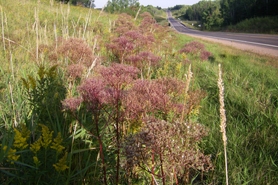Garden heliotrope or Valerian
(Valeriana officinalis)
Tall (1-5') herbaceous perennial with fleshy stalks. They were introduced as a medicinal plants. Roots have a pungent odor. Plants emerge early in spring.
Other names for this plant include:
- Common names: garden heliotrope, garden valerian, Greek valerian, common valerian
Classification in Wisconsin: Restricted
- Ecological Threat
-
- Invades upland forests, wetlands, marshes, woodland swamps, grasslands, and stream edges.
- Tolerant of both wet and dry conditions.
- It is rapidly expanding its range in northern Wisconsin.
- Early emergence, vigorous growth habits and the ability to self-seed give this species a competitive advantage resulting in the displacement of native species.
- Identification
-
Leaves & stems: Opposite, pinnately compound leaves. 5-25 toothed lanceolate leaflets.
Flowers: White to pale-pink tiny flowers arranged in tight clusters.
Fruits & seeds: Small oblong capsules release abundant powdery seeds.
Roots: White, fleshy rhizomes with thick fibrous roots and a pungent odor.
- Control
- Mechanical:
- Pull, cut or mow plants before flowering.
- Foliar spray with triclopyr or glyphosate.
- Resources
- Sources for content:
- Czarapata, Elizabeth; Invasive Plants of the Upper Midwest: an illustrated guide to their identification and control. The University of Wisconsin Press. 2005. Pg. 70-72
- Robert W. Freckmann Herbarium. The University of Wisconsin-Stevens Point. Valeriana officinalis. [exit DNR]
- Invasive Plant Atlas of New England
- Gleason, H., Cronquist, A. 1991. Manual of Vascular Plants of the Northeastern United States and Adjacent Canada Second Edition; pg 66.



